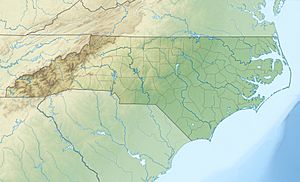Terrells Creek (Haw River tributary, right bank) facts for kids
Quick facts for kids Terrells Creek |
|
|---|---|
|
Location of Terrells Creek mouth
|
|
| Other name(s) | Tributary to Haw River, right bank |
| Country | United States |
| State | North Carolina |
| County | Chatham |
| Physical characteristics | |
| Main source | divide between Terrell Creek and Varnell Creek (Rocky River) pond about 0.25 miles north of Silk Hope, North Carolina 610 ft (190 m) 35°47′07″N 079°22′11″W / 35.78528°N 79.36972°W |
| River mouth | Haw River about 1 mile north of Terrells, North Carolina 374 ft (114 m) 35°49′59″N 079°22′11″W / 35.83306°N 79.36972°W |
| Length | 12.47 mi (20.07 km) |
| Basin features | |
| Progression | east-northeast |
| River system | Haw River |
| Basin size | 29.13 square miles (75.4 km2) |
| Tributaries |
|
| Bridges | Silk Hope Lindley Mill Road, White Smith Road, Castle Rock Farm Road, NC 87, Mt. Olive Church Road |
Terrells Creek is a stream in Chatham County, North Carolina. It is about 12.47 miles (20.07 km) long. This creek flows into the Haw River. It is an important part of the local water system.
About Terrells Creek
Terrells Creek is a stream that flows into the Haw River. Sometimes, people call it "Terrell Creek." It is a vital part of the natural environment in Chatham County, North Carolina.
Where Does it Start and End?
Terrells Creek begins in a small pond. This pond is located near Silk Hope, North Carolina. From its start, the creek flows generally towards the east-northeast. It travels for about 12.47 miles (20.07 km). Finally, it joins the Haw River. This meeting point is about 1 mile north of a place called Terrells.
What is a Watershed?
Every stream and river has a watershed. A watershed is an area of land. All the rain or snow that falls in this area drains into that specific stream or river. Terrells Creek has a watershed that covers about 29.13 square miles (75.45 square kilometers).
In this watershed, the area gets about 47.4 inches (120 cm) of rain each year. About 55% of the land in the Terrells Creek watershed is covered by forests. These forests help keep the water clean. They also provide homes for many animals.



